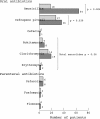Antibiotic selection patterns in acutely febrile new outpatients with or without immediate testing for C reactive protein and leucocyte count
- PMID: 15976341
- PMCID: PMC1770720
- DOI: 10.1136/jcp.2004.024356
Antibiotic selection patterns in acutely febrile new outpatients with or without immediate testing for C reactive protein and leucocyte count
Abstract
Background: Excessive use of broad spectrum antibiotics is related to the spread of drug resistant bacterial strains in the community.
Aim/methods: The effects of immediate testing for C reactive protein (CRP) and white blood cell count (WBC) on physicians' choices of antibiotic was investigated in patients with acute infection. Acutely febrile new outpatients were randomised into two groups: group 1 (147 patients) underwent CRP and WBC testing before initial consultation (advance testing). Prescriptions were compared with those in group 2 (no advance testing; 154 patients).
Results: In non-pneumonic acute respiratory tract infections, 61 (58%) and 122 (91%) of group 1 and 2 patients were prescribed antibiotics, respectively. Cefcapene pivoxil (third generation cephalosporin) and amoxicillin were the most frequently chosen drugs for group 1 and 2, respectively. Total prescriptions of newer, extended spectrum antibiotics (cefcapene pivoxil and clarithromycin (advanced macrolide)) were reduced by 25% in group 1, although they increased in rate (41 (67%) v 55 (45%) prescriptions) because of the decreased prescription of amoxicillin. In group 1, cefcapene pivoxil was preferentially selected when WBC values were greater than 9 x 10(9)/litre. Prescription shifted to macrolides (mainly clarithromycin) in patients without leucocytosis. Patient treatment outcome did not significantly differ between the two groups.
Conclusions: The availability of CRP and WBC data during initial consultation greatly reduced prescription of amoxicillin, but had a lesser effect on newer, potent, broad spectrum antibiotics.
Figures


Similar articles
-
Economic consequence of immediate testing for C-reactive protein and leukocyte count in new outpatients with acute infection.Clin Chim Acta. 2005 Oct;360(1-2):114-21. doi: 10.1016/j.cccn.2005.04.017. Clin Chim Acta. 2005. PMID: 15964561
-
C-reactive protein measurement in general practice may lead to lower antibiotic prescribing for sinusitis.Br J Gen Pract. 2004 Sep;54(506):659-62. Br J Gen Pract. 2004. PMID: 15353050 Free PMC article. Clinical Trial.
-
[A randomized controlled trial of the use of CRP rapid test as a guide to treatment of respiratory infections in general practice].Ugeskr Laeger. 2001 Jul 2;163(27):3784-7. Ugeskr Laeger. 2001. PMID: 11466986 Clinical Trial. Danish.
-
Antibiotic use in dental practice. A review.Med Oral Patol Oral Cir Bucal. 2007 May 1;12(3):E186-92. Med Oral Patol Oral Cir Bucal. 2007. PMID: 17468711 Review.
-
[Summary of NHG practice guideline 'Acute cough'].Ned Tijdschr Geneeskd. 2012;156(0):A4188. Ned Tijdschr Geneeskd. 2012. PMID: 22917039 Review. Dutch.
Cited by
-
Test-treatment RCTs are susceptible to bias: a review of the methodological quality of randomized trials that evaluate diagnostic tests.BMC Med Res Methodol. 2017 Feb 24;17(1):35. doi: 10.1186/s12874-016-0287-z. BMC Med Res Methodol. 2017. PMID: 28236806 Free PMC article. Review.
-
Point-of-Care C-Reactive Protein Testing to Reduce Antibiotic Prescribing for Respiratory Tract Infections in Primary Care: Systematic Review and Meta-Analysis of Randomised Controlled Trials.Antibiotics (Basel). 2020 Sep 16;9(9):610. doi: 10.3390/antibiotics9090610. Antibiotics (Basel). 2020. PMID: 32948060 Free PMC article. Review.
-
Microbiological point of care testing before antibiotic prescribing in primary care: considerable variations between practices.BMC Fam Pract. 2017 Jan 26;18(1):9. doi: 10.1186/s12875-016-0576-y. BMC Fam Pract. 2017. PMID: 28125965 Free PMC article.
-
Biomarkers as point-of-care tests to guide prescription of antibiotics in people with acute respiratory infections in primary care.Cochrane Database Syst Rev. 2022 Oct 17;10(10):CD010130. doi: 10.1002/14651858.CD010130.pub3. Cochrane Database Syst Rev. 2022. PMID: 36250577 Free PMC article.
References
-
- File TM Jr. Overview of resistance in the 1990s. Chest 1999;115:3S–8S. - PubMed
-
- Archibald L, Phillips L, Monnet D, et al. Antimicrobial resistance in isolates from inpatients and outpatients in the United States: increasing importance of the intensive care unit. Clin Infect Dis 1997;24:211–15. - PubMed
-
- Gonzales R, Steiner JF, Sande MA. Antibiotic prescribing for adults with colds, upper respiratory tract infections and bronchitis by ambulatory care physicians. JAMA 1997;278:901–4. - PubMed
-
- Linder JA, Stafford RS. Antibiotic treatment of adults with sore throat by community primary care physicians: a national survey, 1989–1999. JAMA 2001;286:1181–6. - PubMed
-
- McCaig LF, Besser RE, Hughes JM. Trends in antimicrobial prescribing rates for children and adolescents. JAMA 2002;287:3096–102. - PubMed
Publication types
MeSH terms
Substances
LinkOut - more resources
Full Text Sources
Medical
Research Materials
Miscellaneous
